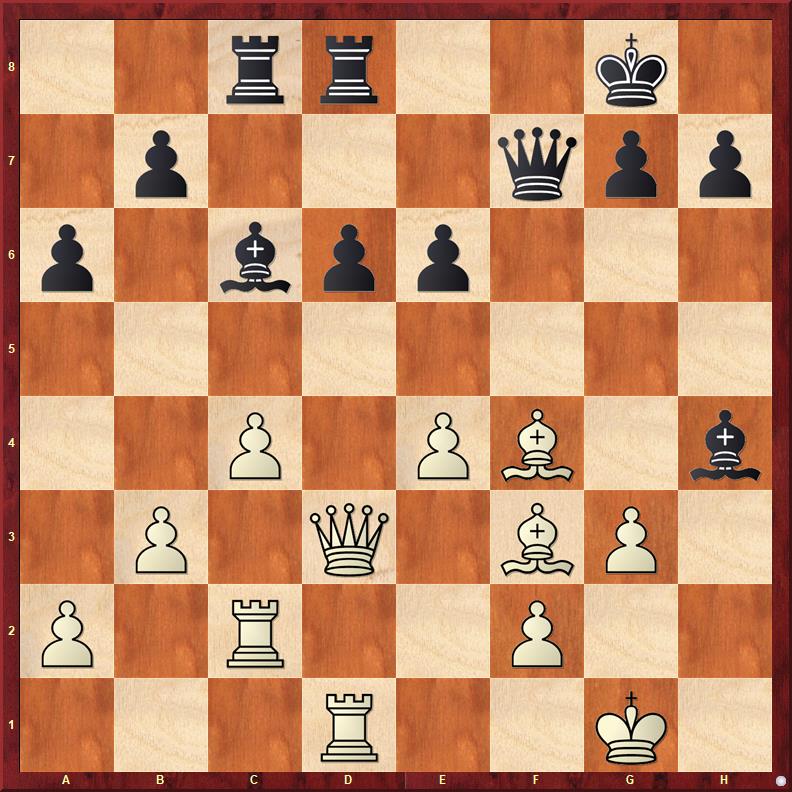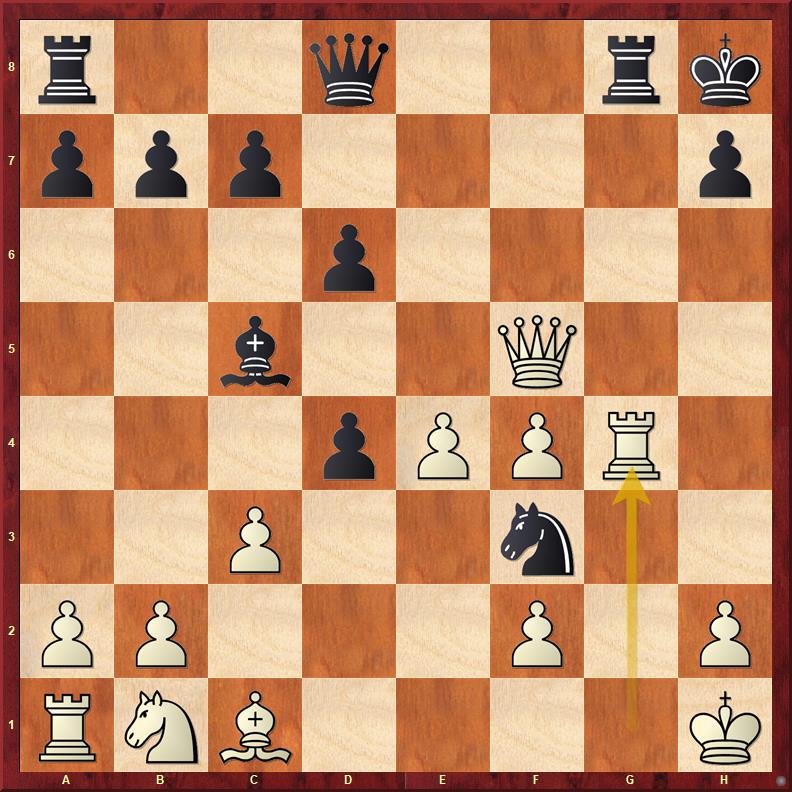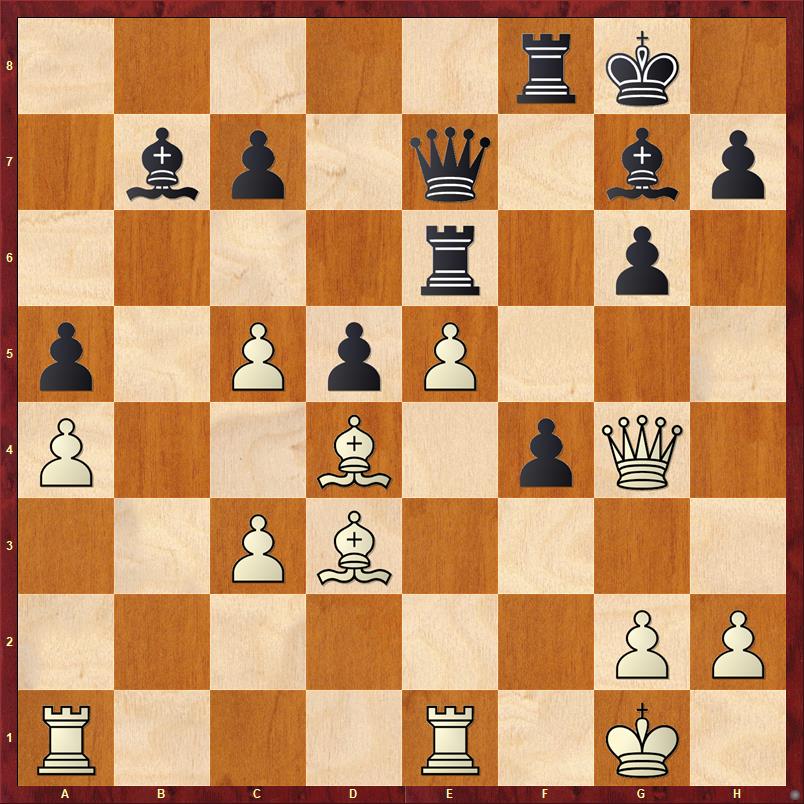This is the position after Black’s 22nd move in a game between Stanislaw Praczukowski (2160) and Minas Mikinas (1951) Graz (2024). The question is: can White capture the pawn on d6?
Read More »Category: Game analysis
Just a funny puzzle
Another classic! This time by the first World Champion: Wilhelm Steinitz with black against Reiner. It was played as part off a match in Vienna (1860). Steinitz won this match with 3-0. ChessGames.com says they were ‘casual games’. Question: how did Steinitz win this game?
Read More »Chess puzzle: who is better and why?
How would you judge this position, which arose after the 25th move by white in the game between Ponomariov and Bareev (FIDE Wch k.o. Moscow 2001). Question: who is better and can black take the pawn on e5?
Read More »What is the best move for black?
 This a position after white’s 25th move. It is from one of my own games. At our level we make (too) many mistakes. But it doesn’t mean that there are no interesting moments.
This a position after white’s 25th move. It is from one of my own games. At our level we make (too) many mistakes. But it doesn’t mean that there are no interesting moments.
It is clear that black is much better. The white king is not safe and his pawns are weak. Compare both rooks and queens and it becomes clear that black has a winning advantage. But the situation is still a bit tricky and black can go astray very easy. What is the best move for black?
To take or not to take? That’s a hell of a question
 The Norwegian International Master Johan Salomon regulary posts chess puzzles on Twitter.
The Norwegian International Master Johan Salomon regulary posts chess puzzles on Twitter.
The diagram position is one of those puzzles (Vasiliy Korchmar vs Ruslan Ponomariov after black played 19. – Ng4).
In fact he posted two puzzles where a knight was en prise. The first puzzle was a bit trivial. I don’t mean this in a condescending way. I love easy puzzles, especially when I see the solution within the blink of an eye. It gives me the feeling that I am not such a bad player after all. The second puzzle was very tricky and certainly not so easy to answer.
Attention grabber
There was another aspect of this position that sparked my interest. It has to do with the structure. For me it was clear that this is an example of the Modern Benoni with Bg2. This position can arise through the first moves of a Catalan setup. I play the Catalan almost exclusively and have difficulties to deal with the black set up.
Recently some more games were added to my bumpy ride with this opening. It started last year in the Malmö GP. There I played against a 2200+ player. Things went from bad to worse and finally to completely hopeless. The time control was 50 minutes per player for the whole game. My only hope was to trick this guy somewhere when time trouble would set in.Read More »
How strong were the old masters?
It is difficult to say how strong these players were. You can’t compare them with modern grandmasters. The modern grandmaster stands on the shoulders of these giants of the past. In the old times a lot of stuff needed to be invented. Steinitz himself was one of the first grandmasters who formulated basic chess principles.
 These principles, which favored a more cautious and positional style, were not to every-bodies liking. Most of the (top) players in that era were still stuck in the Romantic way of playing chess. This meant:
These principles, which favored a more cautious and positional style, were not to every-bodies liking. Most of the (top) players in that era were still stuck in the Romantic way of playing chess. This meant:
Go for the attack and try to beat you opponent with great combinations.
Defense seemed not very important. Only a coward plays defensive moves! Here you have an example.Read More »
The Baden Baden chess tournament
 If you are vaguely aware of the chess history you might wonder: ‘Baden Baden’ where did I hear this name before? Well the Grenke Chess Classic is not the first chess tournament held in this spa town.
If you are vaguely aware of the chess history you might wonder: ‘Baden Baden’ where did I hear this name before? Well the Grenke Chess Classic is not the first chess tournament held in this spa town.
In fact the first super tournament in the history of chess was held in this picturesque town.
The 1870 chess tournament was stronger than previous tournaments in London (1851 and 1862) and Paris (1867).
Compared to these earlier tournaments some rules were changed. First chess clocks were introduced. The players had to make 20 moves per hour. Before draws did not count. Games had to be played all over again. Now draws counted as half a point. And only top international players were invited. These are their names:Read More »
#2 What is the threat?
 In this position black played 1. … a5? Why is this a mistake? Answer…
In this position black played 1. … a5? Why is this a mistake? Answer…
#1 What is the threat?
Usually you win games by playing good moves. Or playing one really bad move less than your opponent. But a chess game revolves not only about our own moves. We have to consider what our opponent is trying to achieve.
Mature chess players possess important qualities such as recognizing and meeting threats in their chess games.
Of course this is something different than what is asked from us in for instance the usual chess puzzles. These puzzles train us to see things from our own perspective. The emphasize is on ‘our own’ possibilities.
Although it is great training to solve chess puzzles, they don’t help us to exercise more caution. On the contrary. At some moment you might start to look for a combination in any position! I hope the new series ‘what is the threat’ on this chess blog will be helpful. It certainly made me more aware of my opponents plans and threats.
I have to thank Dan Heisman for giving me the idea for this series. His fine book ‘Looking for trouble’ is very instructive and contains lots of good examples. Which I will not, for obvious reasons, repeat here.
The diagram position arose after black played 13. … Qa5 in the game between Etienne Bacrot and Alexander Morozevich (Oykovsky Karpov 2014).
Question:
What is black’s threat and how can white prevent any trouble?
#1 What is wrong with this move? Even the chess stars err
 At amateur level most chess games are decided by big tactical mistakes. The average game on the popular chess.com lasts only about 25 moves. If I look to my own games the picture is quite similar.
At amateur level most chess games are decided by big tactical mistakes. The average game on the popular chess.com lasts only about 25 moves. If I look to my own games the picture is quite similar.
I also noticed that when you do not make big mistakes, you will always be in with a chance to get a good result out of a game. Just don’t blunder!
But that is of course easier said than done. Even my article blunder check didn’t help me. Simply because I did not live up to my own advice. The chess game is very complicated and we tend to oversee stuff in the heat of the battle. Not only us ordinary mortals, but also the big chess stars have their weak moments.Read More »



